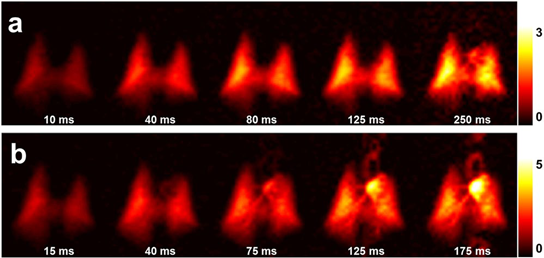This study took advantage of the high polarization of MagniXene®
to explore the dynamics of xenon uptake
into the lung parenchyma and blood in rabbits.
The Chemical Shift of xenon allows for distinguishing NMR frequencies
between gas phase (GP) and dissolved phase (DP)
and separating their MRI images (see Fig.1).
Dr. Kai Ruppert and his colleagues explored the time evolution
of the gas-exchange in rabbit lungs, in healthy subjects and a lung disease model.
Employing a series of innovative pulse sequences
and manipulating the dissolved phase NMR signal,
the gas uptake and subsequent transport through the vasculature of the heart
were studied.
The technique is unique in providing critical information
on the xenon exchange dynamics,
which follows a pathway similar to that of oxygen.
This technology has a high potential
in determining underlying causes of lung diseases
and characterizing lung function at the gas-exchange level.
References:
Sci Rep. 2018; 8: 7310
. K. Ruppert et al.
“Assessment of Pulmonary Gas Transport in Rabbits
Using Hyperpolarized Xenon-129 Magnetic Resonance Imaging.”

Figure 1.
Figure extracted from Kai et al. article
and showing xenon dissolved in lung parenchyma,
blood, and further downstream (arteries, heart).
Depending on the selection of imaging parameters,
different details of gas exchange and transport can be detected.
ABOUT XEMED—We are a product-focused diagnostic drug company with broad expertise and IP in the field of hyperpolarized gases, partnering with clinical researchers and the pharmaceutical industry to advance pulmonary functional MRI through regulatory approval towards worldwide commercial availability.
At Xemed, our mission is to develop inhaled diagnostic agents that are capable of improving the standard of care of respiratory diseases. We will accomplish this by establishing hyperpolarized gas as a scientifically robust, clinically validated, FDA approved, and publically available diagnostic agent for magnetic resonance imaging of lung functional microstructure. We work to demonstrate effectiveness in two fields: 1) guiding clinical management of respiratory diseases, and 2) as a drug development tool to evaluate of the safety and efficacy of new therapies
